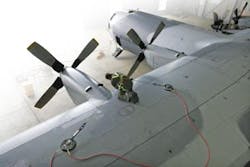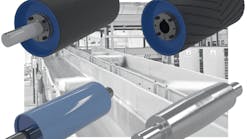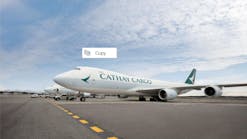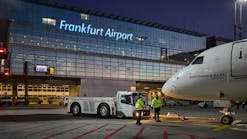Vacuum-based fall protection systems attached directly to aircraft are growing in popularity as a cost-effective way to ensure safe maintenance and construction. But they also impact on other aspects of maintenance operations, as Tim Fletcher of Latchways explores, in discussion with some typical users.
Globally, falls from height continue to be a major cause of death and injury in the workplace. Apart from the devastating impact on the families involved, they can also result in legal action with substantial damages and even criminal prosecution if safety systems have not been installed and used properly. In addition, specific legal measures continue to be introduced nationally – such as OSHA in the United States and the Temporary Working at Height Directive in Europe – although the same principles apply internationally. These measures include where fall protection is needed, which systems are acceptable and who is responsible. All those who instruct or allow operatives to work at high elevations have a clear responsibility for their safety. This applies to both companies and individuals – including aircraft owners and managers.
Popular vacuum systems
Various solutions to workforce protection are used in the aircraft industry, ranging from comprehensive docking assemblies to hangar-fixed overhead cable systems using retractable lifelines. Vacuum based systems are relative newcomers and take a fresh approach with attachment to the aircraft itself. Generally, they are suitable for the majority of fixed-wing aircraft and can be attached to wings, fuselage, or stabilizers. Workers wear a full body harness attached to the system – usually via a safety lanyard and work positioning rope – enabling safe, hands-free access for maintenance. Although usually intended for fall restraint, these systems should be tested and rated for fall arrest, and engineered with a generous safety factor. The energy generated by a fall is absorbed by the system, bringing the worker safely to rest.
Added flexibility
Vacuum-based systems avoid the intrinsic problems of fixed overhead cable systems which prescribe exact aircraft positions in the hangar and complicate use of overhead cranes and other equipment. They also offer maintenance managers considerable flexibility in a number of other areas. Take Shannon Aerospace Limited in Ireland for example, where four heavy maintenance bays are in constant demand. A fixed overhead fall protection system was supplemented by an 8-ton mobile crane, used for access as well as lifting, until introduction of the vacuum based systems. Shannon Aerospace’s Adrian Petticrew explains: “The single crane is always in demand for lifting engines and other items and has now been freed up to maximize this role. In fact we have introduced a scheduling system for it. We make extensive use of Wingrip systems, which give us flexibility in locating aircraft where we want within the hangar, compared with the fixed positioning demanded by overhead fall protection systems. This is important with the wide range of aircraft we handle, including all Boeing series 737s, 757s, and 767s, all Airbus 320s, and MD-80s. We now have 200 people trained to use the system and, after some initial reticence, they are all very comfortable with it – particularly as it is quick and flexible to use. Although we have not needed it yet, the facility to carry a system on board for remote working is a useful capability.
“One vital aspect for us is the ability to use the system in complete safety with fuel tanks open. Different equipment rated for this usage tends to be very expensive.” This is possible because Wingrip vacuum pads are powered by compressed air or nitrogen, without the need for batteries, electrical cables, or large equipment. Being completely non-electrical and with no metal on metal moving contact, the system is inherently safe with fuel tanks open. If the air/nitrogen supply should fail, an audible alarm sounds and the vacuum pad will maintain a safe working vacuum for at least 20 minutes. Petticrew summarizes: “Our experience is that this system provides a safe, reliable, and user-friendly system and we have recommended it to other subsidiaries of Lufthansa Technik. In addition to having confidence in the system itself, training and long-term support from vacuum-based system manufacturers is also essential.”
Simplified access
A very different operation is BAE Systems’ Nimrod maintenance program which operates from small pre-World War II hangars in the UK. Here, Nimrod military aircraft are subject to in-depth work over periods of at least three months and just two can be accommodated in each hangar. Aircraft are always jacked, leveled, and docked. A recent internal HSE review highlighted a requirement to improve over-wing working practices. As a consequence, several alternatives were considered, as Gary Matthewman explains: “We looked at bespoke steel, mobile docking rigs with two operating levels – but they proved to be very expensive and inflexible. Anyway, safe access onto wings remained an issue, as docking really only gives safe access to undersides. This is fine for removing flaps and leading edges but leaves operatives on top of wings at risk, for example when removing panels, performing surface inspections, and guiding crane removal/installation of fuel tanks and thrust reversers.
“Using vacuum-based systems to mitigate risks with fall arrest for wing access works well for us, and is much easier and safer to install than mobile docking – and a fraction of the cost. Most of our operatives have been in the job for many years but they soon familiarized themselves with the new regime. Being able to use the Wingrip system with fuel tanks open is essential and the multi-user capability particularly useful.” The system consists of two end-anchor vacuum pads with a single or pair of cables spanning between them and intermediate pads as needed. Installation and removal are safe and straightforward for a single worker to carry out, as vacuum pads weigh less than 13.2 pounds (6 kg). Each pad is positioned and vacuum locked in place, then the stainless-steel safety cables connected and tensioned at one end.
Simple and portable solutions
Various systems offer different operational characteristics: for example, up to four workers can use the Wingrip® system – two per cable – wearing full body harnesses with a safety lanyard and work positioning rope. This allows hands-free movement along the whole cable length, with shuttles gliding over intermediate anchor pads. As an alternative to cable systems, a vacuum pad can also be used as a single fall protection anchor point for one worker on wings, fuselage, or stabilizers. Quickly and easily installed, and highly portable, single-user systems are particularly suited to line maintenance and other short-term, temporary work. In the case of Wingrip, an adjustable work positioning rope provides a safe working radius of 9.84 feet (3 m) and is particularly helpful to locate the worker for comfortable hands-free working. Where necessary, two vacuum pads can also be used to triangulate and fix the worker’s position. These systems can be used in wet or dry conditions, in or outside hangars, and can be stowed on aircraft for transportation to other sites – including in theatre by the military.
Additional ReSources
Latchways plc, Devizes, Wiltshire, UK
Tel: +44 1380 732700
Fax: +44 1380 732701
Web: www.latchways.com




